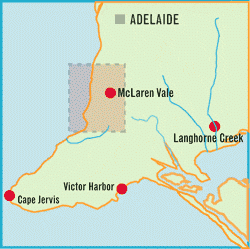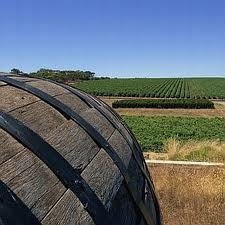|
On The Grapevine,
August 2012 Bro Mike , Wine Correspondant About the region
Only a half hours drive south of Adelaide it is one of Australia's oldest winemaking regions. Driving over the first row of hills one is met with a vista of undulating vineyards surrounding pretty townships, the backdrop the wave-like South Lofty Ranges rolling to the sea. The township of McLaren Vale is central to this region, with Reynella and Clarendon to the North, Kangarilla on the Eastern Boundary, Aldinga on the coastal edge to the West, and in the South, Mount Compass and Sellicks Hill.
McLaren Vale was named after a scot David McLaren, the Colonial Manager of the South Australia Company who arrived in the colony in 1837 and left in 1840. In 1841, John Reynell, from Devonshire, planted 500 vine cuttings near the present township of Reynella. Englishman George Pitches Manning established Seaview winery in 1850. Thomas Hardy, another Devonshire man, and winemaker already growing vines on the outskirts of the young Adelaide City, purchased the Tintara winery from Dr. A. C. Kelly in 1873. Through Thomas Hardy's innovative ideas and rapid expansion this was considered by many to be the beginning of McLaren Vale's wine industry. By 1889 more than 7300 acres were under vine and 70 recognised winemakers worked in the colony (including Pirramimma - established in 1892 and still owned by the Johnston family today). Much of the award-winning wines produced in the region today come from 100-year old vines. McLaren Vale applied for Geographic Indication in 1995 and was awarded regional status in 1997. The topography of the region is undulating and thus contains a variety of terroirs. In the East the land rises as high as 320 metres, but the flats mostly swell between 50-100 metres elevation. Different soil types can be found in this region, including terra rossa soils, light loam over clay, rendzina soils, soldolic, and Bay of Biscay soils. The soil type is generally quite poor with much of it sandy with a clay base. Drip irrigation helps where nature is lacking, although about 20% of the regions fruit is retained as "dry-grown" to encourage intense flavours.
The flats of the McLaren Vale are compared often with the Mediterranean climate, warm sunny days with fresh sea breezes from the nearby Gulf of St Vincent to temper high summer heats. Its proximity to the Mount Lofty Ranges sees the cool gully winds fall down from the hills in the late evening and early morning, chilling the grapes to retain crisp acidity and structure. Good winter rainfall (580-700mm) and low relative humidity ensure consistency of ripening and premium quality fruit. Frost is rare, as is rain before vintage. Long dry summers through to late autumn, with a mean January temperature of 21.7ºC and 1920 heat degree days, means McLaren Vale is considered one of the safest wine growing regions in Australia.
Best wineries to visit and places to stay With its temperate climate and proximity to the ocean McLaren Vale is a nice place to visit most of the year although autumn and spring are the most comfortable for wine touring. It is about an eight and a half hour drive from Melbourne via Langhorne Creek another interesting wine area near the end of the Murray river system. A four to five day round trip is well worthwhile.
McLaren Vale’s 70 plus wineries and cellar doors are a mixture of international wine brands, family-owned businesses and artisan winemakers delivering a complete offering of premium red and white wines within close proximity. My favourite wineries to visit not only for the wine but interesting cellar doors, history or scenery are Chapel Hill, Coriole, Chateau Reynella, d'Arenberg, Samuels Gorge, Hardy's Tintara, Pirramimma and Wirra Wirra. Other very good wineries include Richard Hamilton, Fox Creek, Gemtree, Paxton, Shottesbrooke and Kangarilla Road.
I normally stay at Serafino Wines (originally McLarens on the Lake) a picturesque 300 acre property in the heart of the wine area with lovely quiet accommodation and an excellent restaurant. You can get good value packages, particularly midweek. If you like the seaside there is a variety of accommodation suiting all price ranges at nearby Aldinga.
The Wines Cabernet Sauvignon: McLaren Vale’s signature variety that continues to win awards locally and internationally. The wines are full bodied and rich, often with a touch of dark chocolate intermixed with black currant, but they avoid overripe, jam-like characteristics. The tannins are plentiful but soft, and the wines have the structure for long aging. Try a Shottesbrooke Estate Cabernet for typical good value wine.
Grenache: This variety has enjoyed a spirited renaissance during the last decade. The older plantings produce incredibly richly flavoured wines, with an almost juicy sweetness. Samuels Gorge make a lovely Grenache.
Shiraz: For much of the 20th century, as in so many of the premium wine growing districts of Australia, Shiraz is the backbone of the industry. It produces a densely coloured, richly flavoured wine that quickly develops a velvety texture and carries high alcohol levels with ease. Too many to list all my favourites but the Chapel Hill Vicar shiraz and Wirra Wirra RSW shiraz are up there with the best anywhere in Australia and Kangarilla Road have some very good value shiraz's.
Chardonnay: Since its introduction a little over 15 years ago, Chardonnay has, not surprisingly, established a stranglehold on white grape plantings in the region. The style varies according to site, winemaker input and vintage conditions, ranging from elegant, citrus-tinged wines through to richer, fleshier, peachy and buttery versions.
To sum up Next time you have a spare few days to relax I highly recommend a visit to McLaren Vale to enjoy the wines, food, historical cellar doors and scenery. |
|
|





